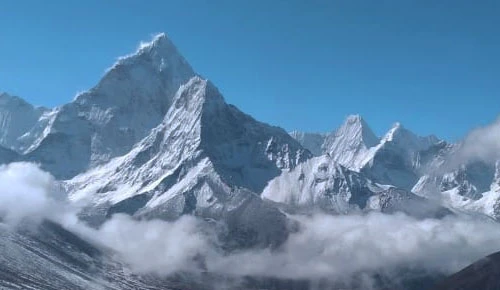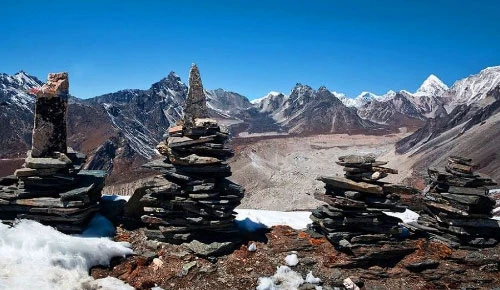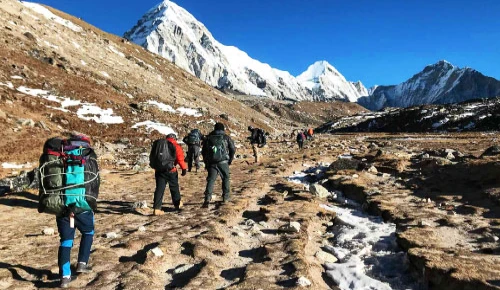Best Season for Everest Base Camp Helicopter Tour
Everest Helicopter Tour is an exciting and memorable experience that allows you to see the beautiful Everest region in Nepal. Instead of trekking for several days to reach the base camp, you can take a helicopter for a convenient and thrilling trip. It's a one-day program that allows you to explore the Everest region's beautiful mountains.
During the tour, you’ll fly above the majestic Himalayan mountains and see snow-capped peaks, deep valleys, and vast glaciers. You’ll also get a close-up view of Mount Everest and the surrounding peaks, including Lhotse, Nuptse, and Ama Dablam.
The helicopter tour is a great way to see the beautiful Everest region in a shorter time frame. It’s perfect for people who have limited time or physical limitations that prevent them from trekking.
Throughout the tour, you’ll have the chance to take stunning photos, create lasting memories, and appreciate the natural wonders of the Himalayas. If you’re an adventure enthusiast or simply looking for a once-in-a-lifetime experience, the Everest base camp helicopter tour with landing is a great option to immerse yourself in the grandeur of the world’s highest mountain range.
Table of Contents
Weather and Climate Considerations
When planning a helicopter tour to Everest base camp, it's important to consider the weather and climate conditions. These factors play a crucial role in determining the best time for the tour and ensuring a safe and enjoyable experience. Understanding the weather patterns and temperature variations can help you prepare adequately for the trip and make the most of your adventure. By considering the weather and climate, you can choose a season that offers clear skies, favorable temperatures, and minimal chances of adverse conditions. This overview will provide you with valuable insights into how weather and climate impact the helicopter flight and help you make an informed decision about the best time to embark on this incredible journey.
Best Season for Everest helicopter tour
Everest helicopter tours can be done throughout the year, but during autumn and spring, the weather is more favorable and the visibility is 99 percent clear. Here are four tables representing each season, including the columns for month, temperature, weather, and suitability for a helicopter:
Spring
Month | Temperature (°C) | Weather | Is it suitable for a helicopter tour? |
March | 10-15 °C/Mild | Showers, partly cloudy | Yes |
April | 12-18 °C/ Mild | Sunny, occasional showers | Yes |
May | 15-20°C/Warm | Sunny, occasional storms | Yes |
Summer
Month | Temperature (°C) | Weather | Is it suitable for a helicopter tour? |
June | 20-25°C/Warm | Sunny, occasional rain | Yes |
July | 25-30°C/Hot | Sunny, occasional haze | Yes |
August | 25-30°C/Hot | Sunny, occasional storm | Yes |
Autumn
Month | Temperature (°C) | Weather | Is it suitable for a helicopter tour? |
September | 18-23°C /Warm | Sunny, cool nights | Yes |
October | 12-18°C/ Mild | Sunny, occasional rain | Yes |
November | Cold | Cloudy, occasional fog | Yes |
Winter
Month | Temperature (°C) | Weather | Is it suitable for a helicopter tour? |
December | 5-10°C /Cold | Snow, occasional rain | Yes |
Janurary | 0-5°C/ Cold | Snow, icy conditions | No |
February | 0-5°C/ Cold | Sunny, occasional snow | No |
Spring Season
During the spring season, which is considered the best time for a helicopter tour, you can experience the beauty of the Himalayas at its finest. This season typically spans from March to May. The weather during the spring is relatively stable, with clear skies and mild temperatures, making it ideal for a helicopter adventure.
Spring offers breathtaking views of snow-capped peaks, including Mount Everest, the highest mountain in the world. The colorful blossoms of rhododendrons and other flowers add a touch of vibrancy to the landscape, creating a visually stunning backdrop for your journey.

Also, spring also allows for better visibility, as the air tends to be less hazy compared to other seasons. This means you have a higher chance of capturing stunning photographs and enjoying panoramic views during your helicopter flight.
The pleasant weather of spring makes it easier to trek and explore the Everest region, as the trails are generally drier and more accessible. You can also expect fewer crowds compared to the peak tourist season, allowing for a more serene and immersive experience.
Autumn Season
During the autumn season, which is considered another ideal time for the helicopter tour, the weather conditions are generally favorable, making it a great time to embark on this thrilling adventure. The autumn season in the Everest region usually spans from September to November.
In autumn, the skies are typically clear, providing excellent visibility of the majestic Himalayan peaks, including Mount Everest. The temperatures are also milder compared to other seasons, making the helicopter tour more comfortable and enjoyable. The days are usually sunny with pleasant temperatures, while the nights may be slightly cooler.
One of the main advantages of choosing the autumn season for the helicopter tour is the stability of the weather. Rainfall is minimal during this time, reducing the chances of flight disruptions or cancellations. This allows you to have a higher probability of experiencing a smooth and uninterrupted tour.

Also, autumn is the post-monsoon season, which means that the surrounding landscapes are beautifully adorned with lush greenery. The valleys and forests come alive with vibrant colors, creating a picturesque backdrop for your helicopter journey. You may also encounter various wildlife species, adding to the charm and diversity of the experience.
Moreover, the autumn season attracts a considerable number of trekkers and adventurers to the Everest region. This creates a lively atmosphere and provides opportunities to connect with fellow enthusiasts and share memorable moments. The local culture and festivals during this time also add an extra layer of cultural richness to your helicopter tour.
Whether you are seeking breathtaking views of the Himalayas, comfortable flying conditions, or a chance to witness the vibrant autumn landscapes, choosing the autumn season for your Everest heli tour is an excellent choice to create lasting memories of this extraordinary adventure.
Challenges and Advantages of Different Seasons
When it comes to planning ahelicopter flight, it's important to consider the challenges and advantages that come with different seasons. Each season presents unique conditions and experiences that can impact your tour.
For example, during the spring season, you can expect milder temperatures and clear skies, making it an excellent time for helicopter tours. The landscape is adorned with blooming flowers and lush vegetation, creating a picturesque setting. However, this is also the peak tourist season, which means more crowds and higher prices.
On the other hand, autumn offers crisp and stable weather conditions, making it another great time for a helicopter tour. The skies are generally clear, providing breathtaking views of the surrounding mountains. The autumn season also boasts vibrant foliage, adding a touch of color to the landscape. Additionally, the number of tourists tends to decrease compared to the spring season.
It's important to consider the challenges that each season brings as well. For instance, spring and autumn may bring occasional rainfall or snowfall, and the weather can change quickly at higher altitudes. Winter brings extremely cold temperatures and limited visibility due to snowfall. Meanwhile, summer is monsoon season, with heavy rains and increased cloud cover, making it less suitable for helicopter tours.
Peak Tourist Season: Pros and Cons
Pros
- Vibrant atmosphere: During the peak tourist season, there is a lively and energetic ambiance around Base Camp. You can see fellow travelers from around the world, making it a social and engaging experience.
- Clear weather and views: The peak season usually offers the best weather conditions, with clear skies and excellent visibility. This allows for breathtaking views of the surrounding mountains and landscapes.
- Availability of services: Since it's the busiest time, you can expect a wide range of services and facilities to be readily available, including accommodations, transportation, and guides.
Cons
- Crowded trails: With many tourists flocking to Base Camp during the peak season, the trails can become crowded, especially in popular spots. This may affect the tranquility and solitude you might seek in a natural setting.
- Higher costs: Due to the increased demand, prices for accommodations, flights, and other services tend to be higher during the peak season. This can impact your budget if you're looking for more affordable options.
- Limited availability: Despite the higher number of services, there might still be limitations or availability issues for certain activities or accommodations. It's advisable to book in advance to secure your preferred options.
- Remember, these pros and cons may vary depending on the specific year and tourism trends, so it's always a good idea to research the current conditions before planning your helicopter ride to base camp during the peak season.
By understanding the challenges and advantages of each season, you can make an informed decision about when to embark on your EBC helicopter tour, ensuring that you have the best possible experience.
Off-Peak Season: Pros and Cons
Pros:
- Less crowded: During the off-peak season, there are fewer tourists, allowing for a more peaceful and serene experience.
- Lower costs: Prices for accommodations, flights, and helicopter tours tend to be lower during the off-peak season, making it a more budget-friendly option.
- More personalized attention: With fewer tourists, you can expect more individual attention and assistance from tour guides and staff.
- Flexibility in scheduling: Since there is less demand, you may have more flexibility in choosing the dates and times for your helicopter tour.
Cons:
- Weather conditions: The off-peak season may have more unpredictable weather, including colder temperatures, stronger winds, and occasional snowfall, which could affect flight schedules and visibility.
- Limited services: Some services, such as accommodations, restaurants, and shops, may have reduced operating hours or may be closed during the off-peak season.
- Limited availability: Since there are fewer flights and tours operating during this time, availability for helicopter tours may be limited, and you may need to book in advance.
- Fewer fellow travelers: If you enjoy meeting and socializing with other travelers, the off-peak season may offer fewer opportunities for such interactions.
- Remember that these pros and cons can vary based on the specific off-peak season you choose to visit Everest Base Camp. It's important to research and consider these factors before making your decision.
Scenic Views and Wildlife Encounters in Different Seasons
A helicopter tour to Everest base camp offers breathtaking scenic views and the opportunity to encounter unique wildlife throughout the year. Each season brings its own charm and distinct experiences for nature lovers and adventure enthusiasts.
In the spring season (March to May), the landscape is adorned with vibrant rhododendron blooms and lush greenery. As you soar above the Everest region, you'll be treated to panoramic views of snow-capped peaks, including the iconic Mount Everest. The clear skies and mild temperatures create ideal conditions for photography and capturing the awe-inspiring beauty of the Himalayas. Keep your eyes peeled for sightings of Himalayan wildlife such as musk deer, Himalayan tahr, and various species of birds.
During the autumn season (September to November), the weather remains stable, with crisp and clear days providing excellent visibility. The mountains are painted in warm hues, and the surrounding forests showcase a stunning array of autumn colors. As you fly over the Everest Base Camp trail, you may spot elusive Himalayan wildlife such as the endangered snow leopard, Himalayan black bear, and elusive red panda. This season also offers magnificent views of the golden sunrise and sunset over the Himalayan peaks.
In the winter season (December to February), the Everest region transforms into a winter wonderland. While the temperatures drop significantly, the snow-covered landscape offers a unique and enchanting experience. The sparkling white mountains stand in contrast to the azure skies, creating a surreal atmosphere. Winter also brings the opportunity to witness the migration of majestic birds, such as the bar-headed geese, as they navigate their way through the high-altitude valleys.
During the monsoon season (June to August), the Everest region receives heavy rainfall, and the skies can be cloudy. As a result, the visibility may be reduced, and the helicopter tour may be less feasible during this time. However, the monsoon season brings lushness to the valleys and hillsides, with waterfalls cascading down the slopes and the landscape rejuvenated with vibrant vegetation.
No matter the season, the Everest helicopter tour promises awe-inspiring scenic views and the chance to spot some of the unique wildlife that inhabits the region. Soar above the Himalayas, immerse yourself in the beauty of nature, and create unforgettable memories on this extraordinary journey.
Preparing for the Helicopter Tour: Essential Items for Each Season
Spring Season
- Lightweight and breathable clothing for moderate temperatures
- Layered clothing for changing weather conditions
- Warm hat and gloves for chilly mornings and evenings
- Sturdy hiking boots for trekking
- Sunscreen and sunglasses for protection against sunburn and glare
- Rain jacket or waterproof outer layer in case of showers
Autumn Season
- Similar clothing as in spring, but with slightly warmer options
- Warmer hat and gloves for cooler temperatures
- Extra layers for colder mornings and evenings
- Comfortable and durable hiking boots
- Sunscreen and sunglasses for sun protection
- Rain jacket or waterproof gear for unexpected rain showers
Note: Regardless of the season, it is important to pack essentials such as a backpack, water bottle, energy snacks, a first aid kit, a camera, and any personal medications you may require. Additionally, it is advisable to check with your tour operator or guide for any specific gear or equipment recommendations based on the time of year you plan to visit.
Cultural and Festive Highlights during the Best Season
During the best season for the base camp helicopter tour, which is typically in the spring and autumn months, travelers have the unique opportunity to witness and partake in various cultural and festive highlights. The Sherpa community, known for their warm hospitality and rich cultural traditions, celebrates several significant festivals during this time. Visitors may get a chance to witness events like Dumje, Mani Rimdu, or Saga Dawa, where locals gather to perform traditional dances, music, and religious rituals. These festivals provide an immersive cultural experience, allowing tourists to gain insight into the Sherpa way of life and their deep-rooted Buddhist beliefs. Exploring the Everest region during these festivities adds a vibrant and celebratory touch to the already awe-inspiring helicopter tour.
In addition to the festivals, the best season for the Everest Helicopter Tour package also aligns with other significant cultural and religious holidays in Nepal. For example, the Hindu festival of Dashain and Tihar, which usually falls in October or November, brings an atmosphere of joy and merriment throughout the country. Travelers can witness the colorful decorations, lively street processions, and the lighting of oil lamps (diyas) that illuminate the surroundings. Engaging in these cultural festivities adds an extra layer of cultural immersion and enriches the overall experience of the helicopter tour, allowing visitors to connect with the local traditions and celebrate alongside the Nepali people.
Safety Precautions for Different Seasons
Here is a list of safety precautions that should be taken during the different seasons.
Spring Season
- Be prepared for changing weather conditions, including sudden temperature drops, strong winds, and occasional snowfall.
- Carry warm clothing layers, waterproof gear, and sturdy footwear.
- Stay updated on weather forecasts and be flexible with your itinerary.
- Beware of avalanches and potential icefall hazards.
Autumn Season
- Prepare for cooler temperatures, especially at higher altitudes.
- Pack appropriate clothing layers, including thermal wear, fleece jackets, and windproof outerwear.
- Be cautious of slippery trails due to occasional rainfall.
- Keep an eye on weather updates and adjust your plans accordingly.
- Stay hydrated and maintain a slow and steady pace to prevent altitude-related illnesses.
Winter Season
- Extreme cold temperatures are prevalent, so dress in multiple layers of warm clothing, including thermal base layers, down jackets, and insulated pants.
- Protect yourself from frostbite by wearing insulated gloves, hats, and face masks.
- Be aware of potential flight delays or cancellations due to adverse weather conditions.
- Follow the guidance of experienced guides and pilots.
- Take extra caution while walking on icy or snowy paths.
Monsoon Season
- Monsoon brings heavy rainfall, so be prepared with waterproof clothing, rain jackets, and waterproof backpack covers.
- Be cautious of landslides and slippery trails.
- Check weather forecasts regularly and consider rescheduling your tour if there are high chances of heavy rainfall or storms.
- Keep an eye on water levels in rivers and streams while crossing them.
- Follow the advice of local guides and pilots regarding safety concerns.
Regardless of the season, it's crucial to stay physically fit, acclimatize properly to higher altitudes, drink plenty of water, and listen to the instructions of your guide and pilot. Safety should always be the top priority during the base camp helicopter ride.
FAQs
When planning a helicopter trip to Base Camp, many travelers have questions about the best season to embark on this adventure. Here, we provide detailed answers to some of the most frequently asked questions to help you make an informed decision.
Q1: What is the best season for a helicopter tour?
The two primary seasons considered the best for helicopter flight are spring (March to May) and autumn (September to November). These seasons offer favorable weather conditions, clear skies, and stable temperatures, providing stunning views of the Himalayan peaks.
Q2: What makes spring a great season for the helicopter tour?
Spring is known for its mild temperatures, blooming rhododendron forests, and longer daylight hours. The weather is generally stable, with fewer chances of rainfall or snowfall. It offers excellent visibility, making it easier to spot the majestic Mount Everest and other peaks.
Q3: Why is autumn considered another ideal season?
Autumn is characterized by clear skies, stable weather, and pleasant temperatures. It is the post-monsoon season, when the skies become clearer after the monsoon rains, offering breathtaking views of the Himalayan range. The landscapes are adorned with vibrant autumn colors, making it a picturesque time for the helicopter tour.
Q4: What are the advantages and disadvantages of the peak tourist season?
The peak tourist season, which coincides with spring and autumn, attracts a higher number of visitors. The advantages include well-established infrastructure, a vibrant atmosphere, and greater availability of services. However, popular trails and accommodations may get crowded, and flight and accommodation prices might be higher.
Q5: Are there any advantages to the off-peak season?
Off-peak seasons like winter (December to February) and the monsoon (June to August) offer their own unique advantages. In winter, the region is less crowded, and you can experience the tranquility of the mountains. The monsoon brings lush green landscapes and a quieter atmosphere. However, both seasons have their challenges, such as extreme cold, snow, or heavy rainfall, which can affect visibility and accessibility.
Q6: How can I ensure safety during the helicopter tour in different seasons?
Safety should be a priority, regardless of the season. It is crucial to choose a reputable tour operator that maintains high safety standards and uses experienced pilots. Follow all safety instructions provided by the operator and be prepared for weather changes. Proper clothing, including layers and suitable footwear, is essential to staying warm and comfortable.
Q7: How far in advance should I book my Everest helicopter tour?
It is recommended to book your helicopter tour well in advance, especially during the peak seasons, as availability can be limited. Aim to book at least a few months ahead to secure your preferred dates and ensure a smooth travel experience.
Q8: Can I expect to see wildlife during the helicopter tour?
While the primary focus of the helicopter tour is the breathtaking mountain views, there is a chance to spot some wildlife, including Himalayan birds and occasionally mountain goats or musk deer. However, sightings cannot be guaranteed, as the tour primarily focuses on the scenic flight flyover at Kala Patthar near Everest Base Camp.
Remember, weather conditions can vary, and it is essential to stay flexible and keep an eye on weather forecasts before embarking on the helicopter tour. Consulting with your tour operator or a travel expert can provide valuable insights and help you plan the best season for your Everest helicopter ride.








